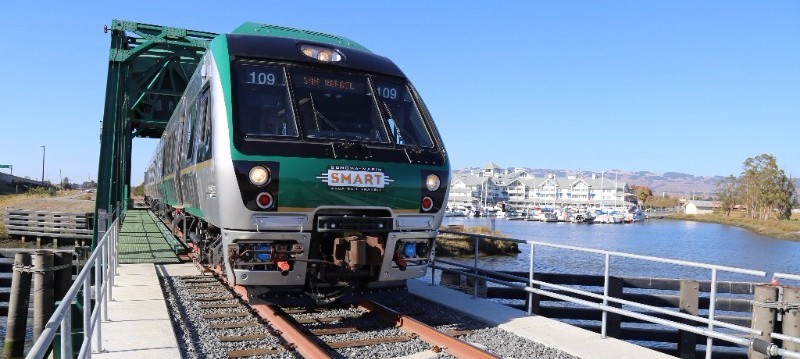
Please be advised that SMART intends to resume overnight testing on Friday, August 30, and continue through Sunday, September 1, between 9:30 p.m. and 8:00 a.m. Regular updates on the testing schedule will be posted on SonomaMarinTrain.org as they become available.
According to SMART, railroad crossing warning devices and train control systems along the new extension from San Rafael to Larkspur must be tested multiple times using trains, and the train horn will be used as required by federal regulations. This is a necessary step to ensuring the public safety of each crossing between downtown San Rafael and Larkspur.SMART’s systems testing also supports the City of San Rafael in its efforts to establish a quiet zone in this area.
We understand that the use of the train horn may be disruptive, and we appreciate your patience as we support SMART’s efforts to complete this testing phase as efficiently as possible. Thank you for your understanding as we strive to ensure the long-term safety of our community. For more information, please visit SMART’s System Testing Update.
Frequently Asked Questions:
Why are the SMART trains testing at night?
SMART must reprogram the system software in order to perform their testing. Due to operational conflicts, this needs to occur when their normal commercial operations have ceased for the evening. Normal route programming is restored prior to morning commercial operations. Additionally, testing in the evening is safer since fewer people are on the road.
Why is SMART using the horn during nighttime testing?
The Federal Railroad Administration (FRA) requires SMART to sound train horns at railroad crossings. (See 49 Code of Federal Regulations 222).
Has the City applied for a Quiet Zone in the neighborhoods near the Larkspur Extension?
Yes, SMART has made the second phase Quiet Zone ready and all of the required signalization has been installed. The City of San Rafael has requested that the Quiet Zone be extended along the alignment from Third Street to Andersen Drive and SMART is planning to accommodate that assuming the California Public Utilities Commission and Federal Railway Administration approve our application. The 60 day comment period has ended. FRA and CPUC will inspect the rail crossings and signalization in late September. Once the crossings and associated signalization is approved, the City can request the implementation of the Quiet Zone with a 30 day notice after the comment period closes. In the initial operating segment, the City decided to implement the Quiet Zone in conjunction with the start of commercial service. SMART will decide when to begin commercial service once their testing is complete. When SMART lets us know when they intend to start commercial service, the City Council can make a decision as to when to implement the Quiet Zone.
Why does the Quiet Zone application end at Andersen Drive?
There is a private rail crossing above Jacoby Street. By FRA rule, the Quiet Zone cannot end at a private crossing. The City of San Rafael is requesting that the FRA and CPUC convert this crossing to a public crossing in order to incorporate it into the City-wide Quiet Zone. Unless and until the conversion is accepted, the City cannot apply for a Quiet Zone at this crossing. Once the conversion takes place, the City can apply, receive comments for 60 days and then provide the thirty day notice to SMART to enact a Quiet Zone at Jacoby Street. The City was not able to do this earlier as all of the Quiet Zone improvements needed to be in place first. In the meantime, the train horn will continue to sound when the train enters this crossing. Currently, SMART expects to operate service to Larkspur from approximately 6:30 am to 8:30 pm daily.
Where will track testing occur?
Track testing will take place on track segments between Mission Ave and Larkspur.
Who do I contact with questions about the testing program?
For updates on SMART’s testing program and the extension to Larkspur, visit SMART’s website at SonomaMarinTrain.org or call 707-794-3077.

